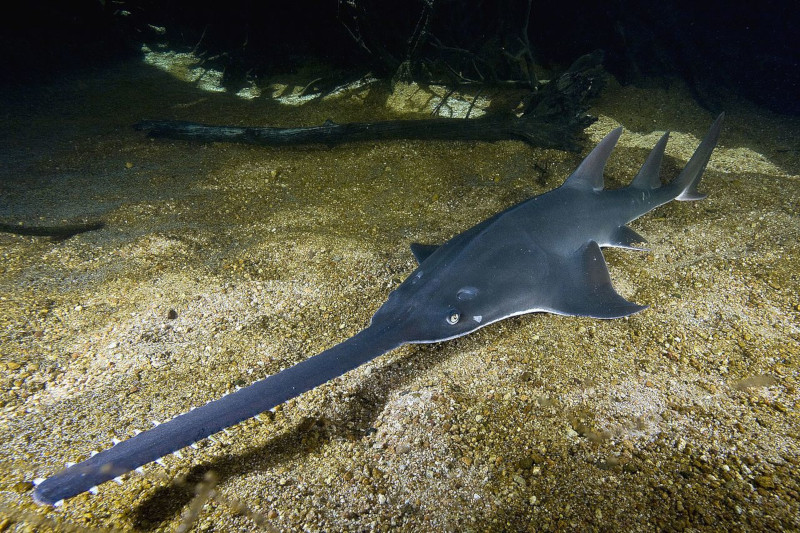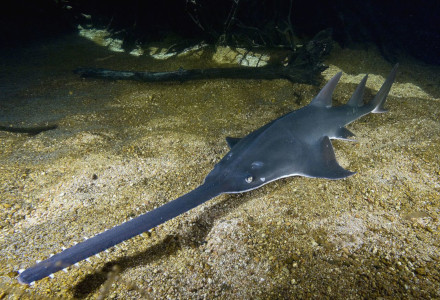
Green Sawfish Facts
- Perhaps most notably, the unique term of Green Sawfish serves as one of the common names for a highly impressive variety of marine fish. Further, this particular species also goes by numerous other common names, in various parts of its range.
- These include those of the Longcomb fish, and the narrowsnout sawfish. Meanwhile, though, this extremely fascinating wonder of Nature also bears a comparatively simple scientific name, unlike some species. It bears the name of the Pristis zijsron.
- Regardless of which name one uses to refer to the creature, it remains a most interesting species. First of all, despite a common belief, as a member of the Pristidae Family, this truly remarkable marine animal actually forms a type of ray.
- In point of fact, many people believe this remarkable creature of the seas to represent another form of shark. Further, and most impressively, it also ranks as perhaps the largest of all currently known species of its type.
- Quite regrettably, though, the presently known population of the marvelous Green Sawfish has declined dramatically in recent decades. As a result of this sad state of affairs, the IUCN currently lists the animal as Critically Endangered.
- Additionally, this lamentable status appears on the organization’s Red List of Threatened Species. It does so for several reasons. Historically, commercial fishing constituted the greatest threat to this particular fish, as it does for so many others.
- Nevertheless, given its current numbers, that threat, though certainly still present, has taken a back seat to others. The dual perils of habitat loss and ongoing climate change likely now form the most severe threats to its continued existence.
Related Articles
Green Sawfish Physical Description
Although many reasons to appreciate the Green Sawfish exist, its most impressive characteristic remains its sheer physical size. Quite interestingly, although it does display the common trait of sexual dimorphism, this species does so in a most unusual manner.
That holds true due to the fact that, in the case of this animal, this manifests itself in terms of the prongs on the rostrum. Firstly, the males possesses an average of 18 prongs on each side of the rostrum. Meanwhile, the females only display a total of 15 of these per side.
Further, the name of the creature partly derives from the color scheme it presents. This holds true because the upper portions of its body display a greenish-brown or olive color. In the meantime, though, the under part of the body has an off-white coloring to it.
The remarkable Green Sawfish also remains noteworthy for its physical measurements. In fact, mature adults of the species attain a body length averaging roughly 20 ft (6 m). However, exceptional specimens occasionally grow to a length of as much as 24 ft (7.3 m).
- Kingdom: Animalia
- Phylum: Chordata
- Class: Chondrichthyes
- Order: Pristiformes
- Family: Pristidae
- Genus: Prisits
- Species: P. zijsron
Green Sawfish Distribution, Habitat, and Ecology
The Green Sawfish evolved as native to a relatively wide area of the world. That’s due to the fact that, according to research, it originally inhabited a huge range. That was an area that covering roughly 2.3 million sq mi (5.9 million sq km) of ocean.
More precisely, historically its range included and area that began with the waters off Australia. This also extended to southeast Asia, the Persian Gulf, the Red Sea, and all the way to the coast of the country of South Africa, on the continent of Africa.
Today, this majestic creature only occupies a tiny fraction of the area it once appeared in. Furthermore, the majority of known individuals now live in one fairly concentrated area. That’s the waters around Australia, including the well known Shark Bay.
This fact sets it apart from related species in yet another manner. That’s because the waters in this area remain significantly colder than those occupied by most rays. The fascinating fish also possesses decided preferences for its choice of habitats.
Firstly, the amazing fish primarily appears in coastal waters. Secondly, though, it also inhabits regions of mangrove forest, and occasionally even appears in various estuaries. It does occasionally venture into rivers, but such trips do not occur often.
It also prefers areas of shallow water. As a result, it rarely appears in areas with depths exceeding 230 ft (70 m). Here, it evolved the state we find it in today. Like other related species, the awesome Green Sawfish evolved as an entirely carnivorous predator.
Despite its fearsome appearance, it remains harmless to humans, unless captured. To its prey, though, it’s a deadly hunter. This mainly consists of various small molluscs, crustaceans, and fish. These it stuns first with its rostrum, by swinging it from side to side.
Species Sharing Its Range
Check out our other articles on 5 Fabulous European Mammals, Victoria Crowned Pigeon, Neptune’s Grotto, Ghost Orchid, Geoffroy’s Cat, White Witch Moth, Plumed Basilisk

